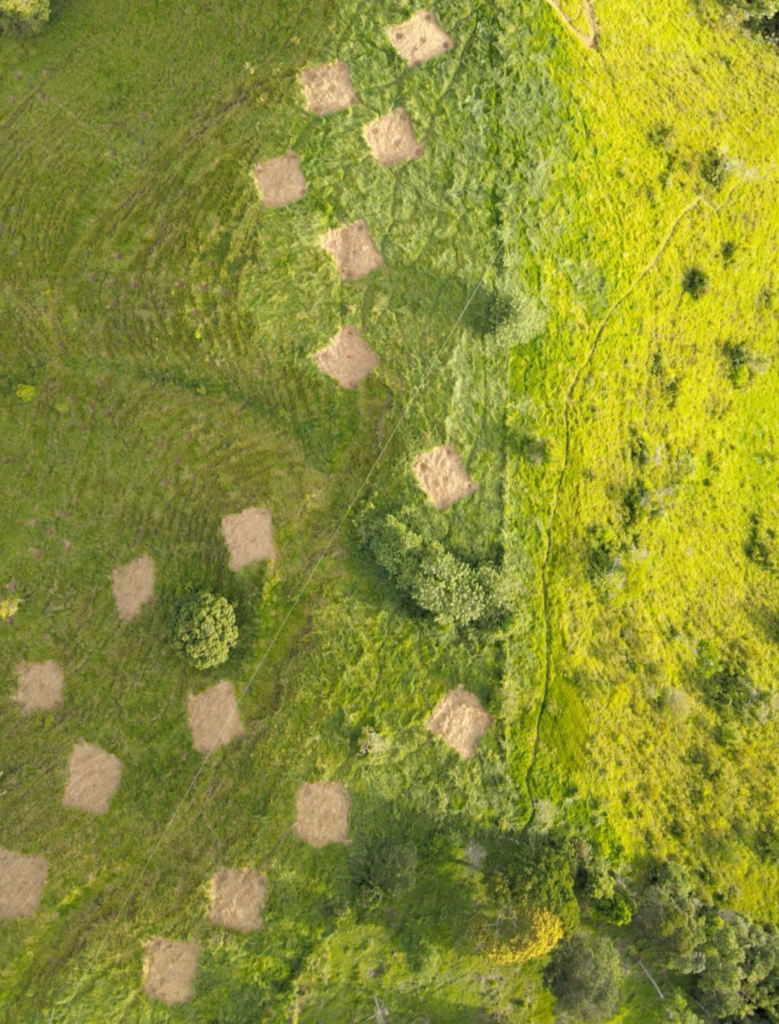Our projects
2022: Antioquia, Colombia
Land Restoration
In late 2022, we have acquired pieces of land in the region of Antioquia, Colombia where more than 60% of it was in a degraded state due to cattle ranching activities. The ecosystem around is very rich and diverse, and acts as a “flora and fauna natural reserve”, helping the land achieve a natural restoration.
On top of letting nature do its work by sowing its seeds, NatureRe’s expert team is assisting it with a variety of soft measures, including weeding, fire prevention, vegetation perches, boundary fencing and control of invasive species. With Natural Regeneration, and specifically through the elimination of stressors (cattle, chemicals…) and implementation of fences, the ecosystem is able to recover its productivity. In areas with low regeneration potential, restoration treatment includes establishing species native to the zone, allowing for the replication of natural succession and an increase in richness. Each type of intervention involves a combination of natural regeneration and planting 19 varieties of native trees, such as wild cashew trees (Anacardium excelsum) and mahogany (Swietenia macrophylla).
Image: green corridors were created by distributing 400 trees in 20m-wide strips with trees planted every 4m in each hectare.


Biodiversity Contributions
Multilayered vegetative cover, in comparison to typical reforestation creates a mosaic of habitats, offering diverse resources, and supporting a wide range of species. This structural complexity contributes to the overall health, resilience, and ecological functionality of ecosystems. We regularly monitor how many species of flora and fauna have reemerged thanks to the 21 monitoring stations installed in different vegetations.
We also protect regional and continental corridors such as the Jaguar Conservation Corridor to connect jaguar populations of Central and South America by allowing them to move from one area to another, guaranteeing the maintenance of the species and the ecosystems. With 50% of the species’ original range having been lost due to illegal poaching, human-jaguar conflict and loss and fragmentation of habitat, this initiative allows for the protection of the species and the ecosystem.
Image: ocelot, anteater and others present on our la
Water Health
Full ecosystem restoration does not only address fauna and flora. It includes other natural resources such as water. Healthy native ecosystems are the only way to balance water and climate extremes
The project area has multiple water resources which in the past supplied a rural aqueduct. Rural community aqueducts are publicly managed and have a community approach, enabling the flow and channeling of water resources, specifically for local consumption.
The micro-watersheds that supply the rural aqueducts are part of a small geographic area, where the water flows through drains with a main exit called spring or source. Micro-watersheds are of vital importance for the development of ecosystems, communities, settlements, and, therefore, the country.
Image: drone shot of water source on our land


Local Communities
To restore our land, we actively work with local communities, consulting with stakeholders to ensure the protection of their land and communities, as well as to ensure fair economic returns. We have hired multiple members of the local community, from rangers, to biologists, to environmental engineers.
With the support of our operational partner South Pole Colombia, we also set up workshops with village inhabitants to better understand their needs and priorities and to ensure access to information, throughout all stages of development. Raising awareness on the operations and sustainable management of forests resources, reforestation strategies and biodiversity protection is essential for capacity and knowledge building.
More projects involving local communities are to come, training opportunities and knowledge-exchange. We need to scale investments into nature restoration with speed and scale, and are currently collaborating with Catona (formerly Aspiration) to share best practices, insights and expertise.
Image: local environmental engineer and property managers working on the project planning and monitoring
2014: Pilot project in Chóco, Colombia
NatureRe has been restoring nature for 10 years now. In 2014, we initiated a pilot project in the Chocó region of Colombia, chosen for its richness in land and biodiversity.
Together with our partner SouthPole Colombia, we carefully selected an area that was mostly degraded to apply Assisted Natural Regeneration.
In total, an area of approx. 8ha in need of restoration of a natural park (350ha) was identified, acquired and restoration processes were started. We used a variety of soft methods to help nature do what it does best: regenerate.
Seven years later, local communities can see the impact of the project: nature has regenerated, and the unique biodiversity of Colombia has flourished once again.
The upper picture shows a part of the acquired area in 2014, before we started with the process of Assisted Natural Regeneration. The bottom picture shows the same area seven years later, in April 2021. You can clearly see the progress made and the impact of Assisted Natural Regeneration on the present ecosystem. In only 7 years, trees have been growing and the land has been flourishing.
With such clear evidence, we realised we needed to scale this project and restore much more land.

Why Colombia



Images: rich fauna and flora photographed on our land
Colombia offers optimal conditions for investments into carbon removal projects. With roughly 10 million hectares of land suitable for commercial restoration, there is vast opportunity for investments into nature.
Colombia is listed as one of the world’s “megadiverse” countries, hosting close to 10% of the planet’s biodiversity. Worldwide, it ranks first in bird and orchid species diversity and second in plants, butterflies, freshwater fishes and amphibians.
Colombia is also importantly advanced in carbon regulation and shows leadership in the race against climate change. In 2021, the country upped their commitment to reduce its greenhouse gas emissions from 20% to 51% by 2030 and be net-zero by 2050. Later this year, they will be hosting the United Nations Biodiversity Conference (COP16).



